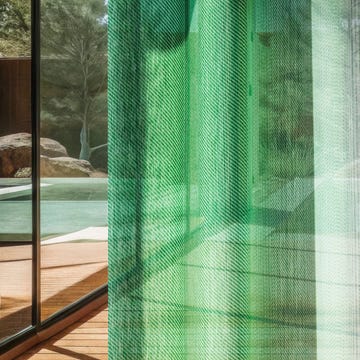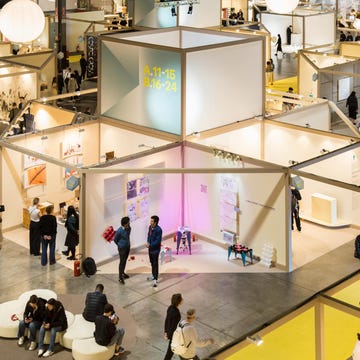Frieze London opened to the public yesterday, and regular visitors will have noticed some major changes for this, its 21st year. In the biggest shakeup of the fair’s design in a decade, relatively young interiors, architecture, furniture and design experts A Studio Between and the fair’s directors Eva Langret & Kristell Chade, have made bold moves to change both the visitor experience, and the environmental impact of the event.
It’s fair to say that the art world has been facing challenges of late, with gallery closures and auction sales reportedly down, but A Studio Between’s founder Richard McConkey, formerly Head of Hospitality at Edward Barber and Jay Osgerby’s Universal Design Studio, has created a new layout for Frieze that puts younger, emerging galleries and curated sections, such as the much-loved ‘Artist-to-Artist’ programme front and centre. It’s a move that celebrates and champions what stands out about the London art scene – it’s youthful creativity and dynamism.
Approach the venue in Regent’s Park and you are met by the main sign, featuring work by Lawrence Lek, the winner of the 2024 Frieze Artist Award – his installation is also given a prominent space inside. In order to facilitate this democratic layout, allowing up-and-comers the chance to shine, the more established galleries have been placed nearer the rear of this vast site, temporary home to 160 galleries and more than 1,000 artists’ creations. It’s a shift that will no doubt have involved much negotiation, but encourages greater freedom of exploration. ‘It’s a deliberate decision to make emerging voices more visible and accessible, and also create balance across the fair,’ says McConkey. ‘The established galleries are positioned in new spaces that are heightened and feel very grand, so it’s not one or the other, but both.’
What's everyone reading?
The whole experience is also much airier – grid-like corridors encourage people to loop around every exhibit, while regular meeting spaces allow a little breathing room and the opportunity to pause. ‘We’ve created more open areas and social spaces than ever before filled with natural light, for visitors, galleries and artists to engage in exchange. And by exchange, I mean conversations; between people, galleries and works,’ explains McConkey, who has scattered the various ‘public squares’ throughout the layout with clusters of furniture created in collaboration with Danish brand Fredericia.
These include Børge Mogensen’s ‘Model 3171’ oak and leather bench, and a new backless version created especially for Frieze with Fredericia and the Mogensen estate. You’ll also spot congregations of Maria Bruun’s ‘Pioneer’ stools, also for Fredericia, locked together by 3D-printed connectors that allow for the seating to be expanded or easily dismantled.
The latter is a theme across all of A Studio Between’s design. This is a fair made to be reused. All of the new seating can be stacked away ready for the next Frieze, while the very structure of the fair itself is also a modular design that’s sustainable and simple to pack away. ‘Sustainability is no longer optional, it’s essential,’ states McConkey. ‘In a world where we’re increasingly aware of our impact, we have a responsibility to reduce waste and prioritise reuse. For Frieze, this meant minimising single-use materials and focusing on lightweight, reconfigurable structures.’ The walls themselves, outside and in, are made from grey, moisture-resistant fibreboard, made from recycled materials and organic dyes, with the sides covered in stretched white mesh. Indoors, the whole system is supported by scaffolding, anchored by water-filled tanks. ‘We’re reducing the fair’s carbon footprint and promoting a longer term approach,’ adds McConkey.
The same eco conscious approach can be seen in the designer’s interiors for Frieze’s pop-up restaurants. For these, A Studio Between has aimed to distill the essence of each venue into the temporary dining rooms. ‘It's about trying to get the feeling of the space rather than a literal representation, but focused for the particularities of Frieze,’ explains the designer. ‘For Sessions House, Jonny Gent & Russell Potter gave us the brief of three great words; Secrecy, The Cinematic and the Studio. So this was about creating space that unfolded, with the use of fabrics and screens to create this layering of views and light, and this feeling of a great dining room – something not fully finished, just like Old Sessions House.’
Using one hero material – artists’ canvas – in three different weights, the A Studio Between team has built an incredibly atmospheric experience. Fabric creates an acoustic softness (an essential break from the chatter of the fair), as well as a soft glow. Pendant lighting is hung low to visually bring down the lofty ceilings to a more human scale, while one wall of windows has been turned into a memorable installation. ‘We brought in long-term collaborator, artist Hattie Fox, to add these planting arrangements which project beautiful shadows,’ says McConkey of the ethereal design.
Her work also makes a strikingly vibrant centrepiece in the Jikoni popup, where McConkey has translated a very personal selection of colours from chef-patron Ravinder Bhogal's childhood into artistic blocks of saffron yellow, dusty pink, indigo, and pistachio green.
What does McConkey want the overall takeaway of this grand rethink to be? ‘It is about enhancing the visitor experience by making the fair more immersive and spacious, whilst always pushing the quality,’ he says. ‘The new layout encourages visitors to experience the fair as a journey of discovery – there are so many amazing pieces and works to explore, I hope that people find something unexpected.’ Frieze London is open until 13 October, frieze.com; astudiobetween.com



















